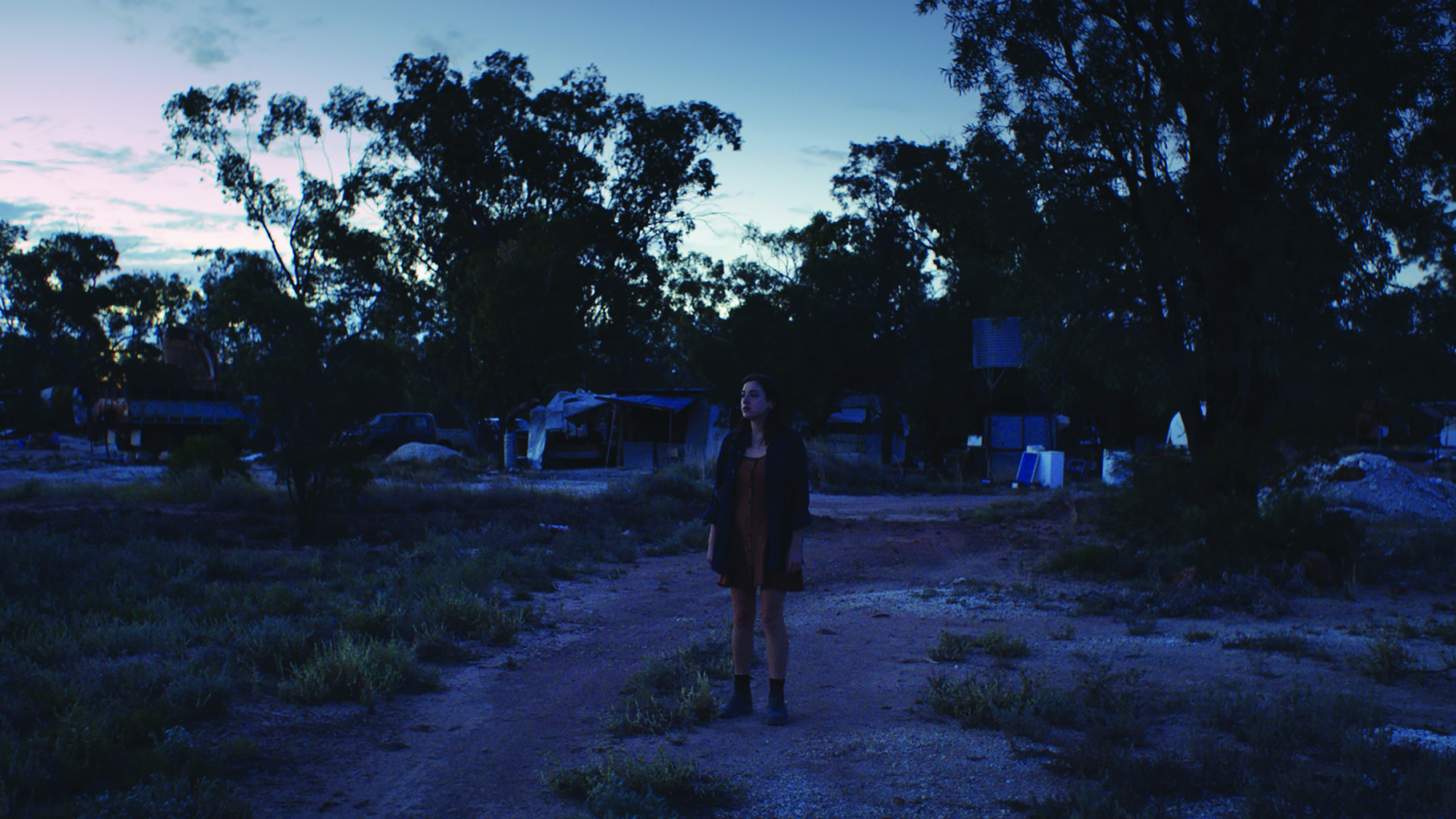The ‘strange’ colours flagged in the title of Alena Lodkina’s remarkable debut feature are first glimpsed in a banal, everyday setting: a shop window. Opals are on sale inside, which cues us in to the fact that opal mining is the main activity in the remote place to which young adult Milena (Kate Cheel) has travelled by bus: Lightning Ridge in northern New South Wales. The immediate motivation for Milena’s trip is the heart attack recently suffered by her now-hospitalised father, Max (Daniel P Jones). But the looming issue of how Milena and Max will come to terms with each other emotionally is sidelined for almost half the film; meanwhile, Milena will wander around this place, encounter its people and spend some reflective time alone.
Lightning Ridge, as we see it here, is an intriguing place. Its inhabitants often remark on its peace and quiet, and its welcome distance from the stressful rat-race of the big cities. Everybody knows and helps out one another, but also respects the desire to be left in restful or pensive solitude. Strange Colours takes its stylistic cues from this environment: it is a patient, contemplative film, keen to record details of place and time, and to evoke the emotions and impressions this setting arouses.
Just as the soundtrack leaves room for delicate moments of complete silence, the images (enhanced by Michael Latham’s cinematography) dwell in a spectrum of shifting colours – much like those refracted by a turning opal – and are often content to approach total darkness, of a kind that is impossible in our artificially illuminated urban centres. Lodkina’s embrace of these qualities of silence and darkness gives certain moments – especially the occasionally wordless interactions between Milena and Max – the gravity and force of an Andrei Tarkovsky film, and a highly painterly quality.
Strange Colours is an elliptical, restrained, understated work. Whatever lurks in the past between Max and Milena, including the details surrounding her mother’s death, is something we will never know. The characters’ inner thoughts can only, for the most part, be inferred as the camera studies their silent faces. The script introduces several arresting complications at its midway point – particularly in relation to Milena’s friendship with another Lightning Ridge local, Frank (Justin Courtin) – but then lets these issues float without any great dramatic resolution or conclusion. Lodkina, as a director, focuses on maintaining the inherent mystery of people and of places.
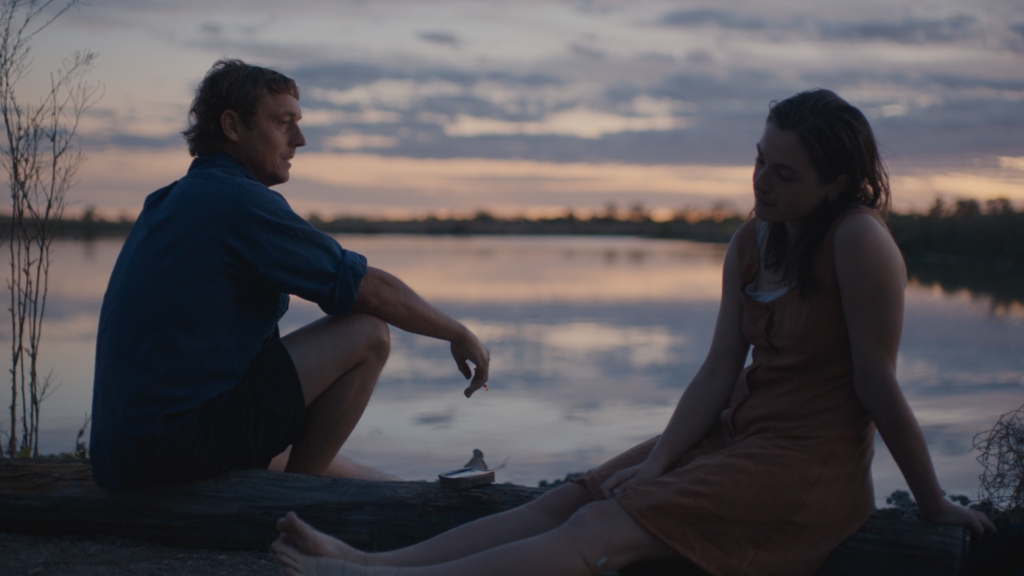
A hard place to leave
The peaceful qualities that make Lightning Ridge appealing to its long-term residents are also given a seductive, slightly supernatural aspect – without the film ever tipping over into horror-fantasy territory. We hear repeated variations on the theme that the Ridge is a ‘hard place to leave’ – that, once installed there, people tend not to budge from it. In this respect, Strange Colours recalls (intentionally or not) Bernardo Bertolucci’s great film based on Jorge Luis Borges’ short story ‘Theme of the Traitor and the Hero’: The Spider’s Stratagem (1970), in which the imaginary Italian town of Tara functions as a lure that catches the story’s nominal hero in its trap. The final images of the adaptation – very likely a direct influence on the ending of Ted Kotcheff’s Australian classic Wake in Fright, made the following year – show the central character waiting eternally on the local train-station platform, giant weeds having, long ago, grown over the tracks. In these examples, a town’s aura of permanence and its weight of tradition become oppressive.
Strange Colours draws a different theme out of its seductive location. On many levels, the film compares and contrasts two different ways of living in the present moment. Milena’s way, at the start, is to be loose, weightless, free, available to whatever is happening – ‘what’s here and now’, as she describes it. This also means, as Max remarks, that she is effectively ‘bouncing around the country like a tennis ball’ – that she’s uncommitted to anything, untethered to any sense of home, family or belonging. Is this sense of belonging what Milena is unconsciously looking for in her decision to visit her father in Lightning Ridge? The film neither makes this motivation explicit, nor resolves it in any clear or clean way; it is very much the mode and mood of the project to remain suspended, to leave us, at the end, still in the middle of a difficult and ambiguous emotional and psychological transition.
The community of Lightning Ridge, however, runs on an alternative notion of the ‘here and now’. One resident casually remarks, ‘Anyway, here we are’ – but the rough-and-ready, spontaneous poetry of his remark (like so much of the film’s dialogue) hints at a deeper understanding. To be truly present in the Ridge means to be rooted, to sink oneself deeply into the Earth and its natural cycles. Mining, far from being a signifier for the pillaging of the land (as it could easily have been portrayed), here represents a type of communion with it, a familiarity with its unique contours and properties. Tellingly, a key moment in the developing relationship between Milena and Max takes place literally below ground, in a mine shaft.
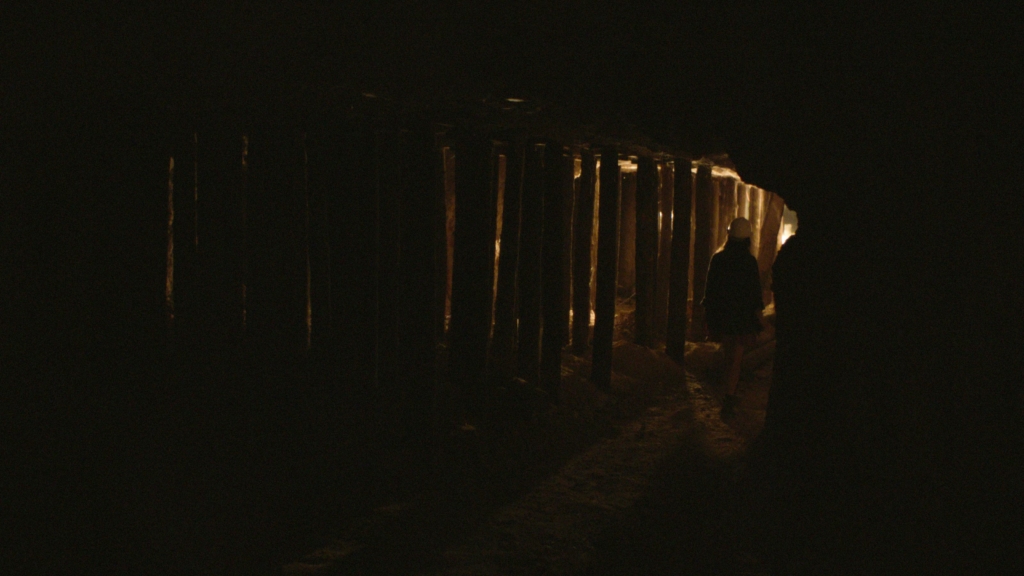
Absence of menace
Strange Colours premiered in 2017 at the Venice Film Festival, following its inclusion in the festival’s Biennale College – Cinema program. At the time, eminent scholar David Bordwell compared it to an Anton Chekhov play, rightly stressing its eschewal of ‘the plotty propulsion of a conventional family-problems movie’. The script, he argued, ‘avoids those traumatic flashbacks that often supply backstory’, and the deliberately parsimonious narrative’s intrigue ‘never creates conventional suspense’.[1]David Bordwell, ‘Venice 2017: College Days’, David Bordwell official website, 7 September 2017, <http://www.davidbordwell.net/blog/2017/09/07/venice-2017-college-days/>, accessed 3 May 2018.
More pointedly, Lodkina’s film also deftly sidesteps the particular forms of suspense that many spectators might immediately expect from the tale of a young city woman in an isolated Australian town. It is completely free of psychosexual menace, and of any Gothic sense of nature itself as a threatening presence – as most famously portrayed in both versions of Long Weekend (Colin Eggleston, 1978; Jamie Blanks, 2008), not to mention the central enigma in the 1975 film (Peter Weir) and 2018 TV renditions of Joan Lindsay’s novel Picnic at Hanging Rock.[2]Editor’s note: Stephen A Russell examines Foxtel’s Picnic at Hanging Rock series, as part of a larger essay on television reboots of historic Australian films, in this issue of Metro; see ‘Recurring Nightmares: Dark Australian Classics Reimagined’, pp. 34–41. This refreshing absence in Strange Colours needs to be underlined: there is no rape, no uncomfortable sexual encounters (physical intimacies go no further than a tentative kiss between Milena and Frank) and no evocation of – to cite the American title given to the Long Weekend remake – ‘nature’s grave’.
A subtle series of details traces Milena’s gradual acceptance that her new lifestyle – for however long it lasts – is no threat. Despite forever waving flies and mosquitoes away from her face, Milena quickly learns that the snake inside Max’s house is not venomous, and that the frog at her feet in the shower should be regarded as just another whimsical, eccentric bush companion. She even takes to sleeping outdoors, under the stars – thus connecting her personal evolution to the film’s recurring pans that show the night sky and her father’s lyrical hospital-bed soliloquy on the Orion constellation.
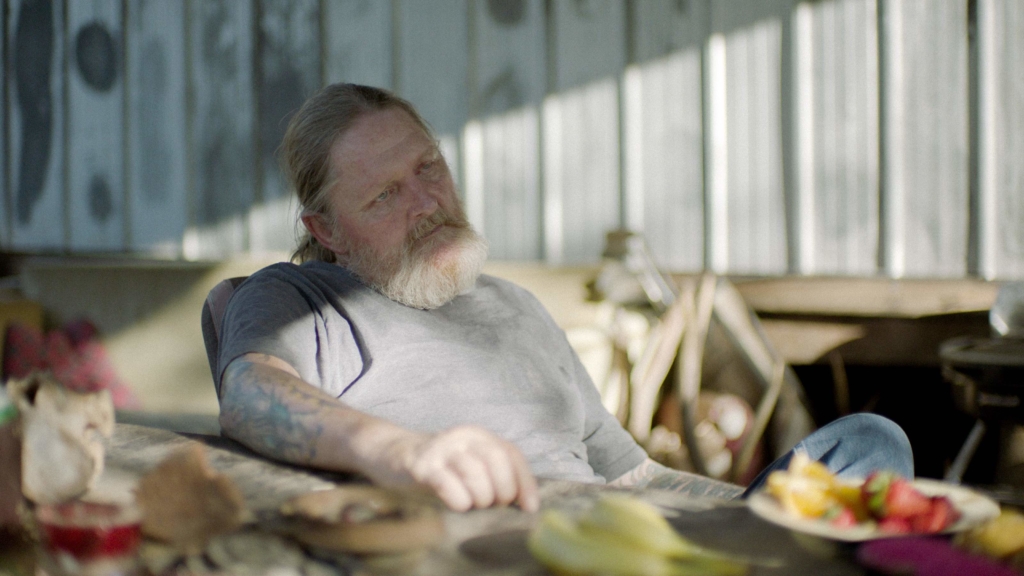
Raggedy coots
Strange Colours offers a fascinating and original portrait of Australian masculinity. Although a few other women can be glimpsed as extras in the background of a pub scene, the film deliberately stylises and abstracts its principal situation to the extent of showing Milena as the lone woman in a world entirely consisting of men, all of whom are older than her (most of them considerably so). Moreover, this male enclave is solidly a ‘white Australia’, without any evident Indigenous input. Lodkina has cited as an influence here another classic of Italian cinema, Roberto Rossellini’s Stromboli (1950),[3]See Amber Wilkinson, ‘Mining the Mystery’, Eye for Film, 5 September 2017, <https://www.eyeforfilm.co.uk/feature/2017-09-05-alena-lodkina-on-feature-story-by-amber-wilkinson>, accessed 3 May 2018. which features Ingrid Bergman as the foreigner and cultural outsider in an oppressively patriarchal Italian fishing village.
Bordwell – writing from his distant, American perspective – associates Strange Colours’ male characters with terms like ‘hard-edged’, ‘gruff’ and ‘flinty’, and regards them as a bunch of ‘[l]ean and raggedy coots’.[4]Bordwell, op. cit. Yet the aura that these men exude is very different from the highly strung, aggressive, even psychotic vibes that we associate with the outback males of many Australian classics, from Wake in Fright to Wolf Creek (Greg McLean, 2005) and beyond. Despite their casually salty language, the men in Strange Colours are not driven by misogyny or homophobia. Even their mocking humour is gentle, rather than brittle or cruelly sarcastic.
These may be blokes of few words, laconic or stoic creatures, but they do not strike Milena (or us) as repressed, bigoted or acting blindly on the basis of defensive projections; they are not, in short, ocker stereotypes. Nor are they identical in their values and behaviour – another apt metaphor that comes courtesy of the town’s opal-mining business is that no two individuals, just like no two opals, are ever exactly the same.
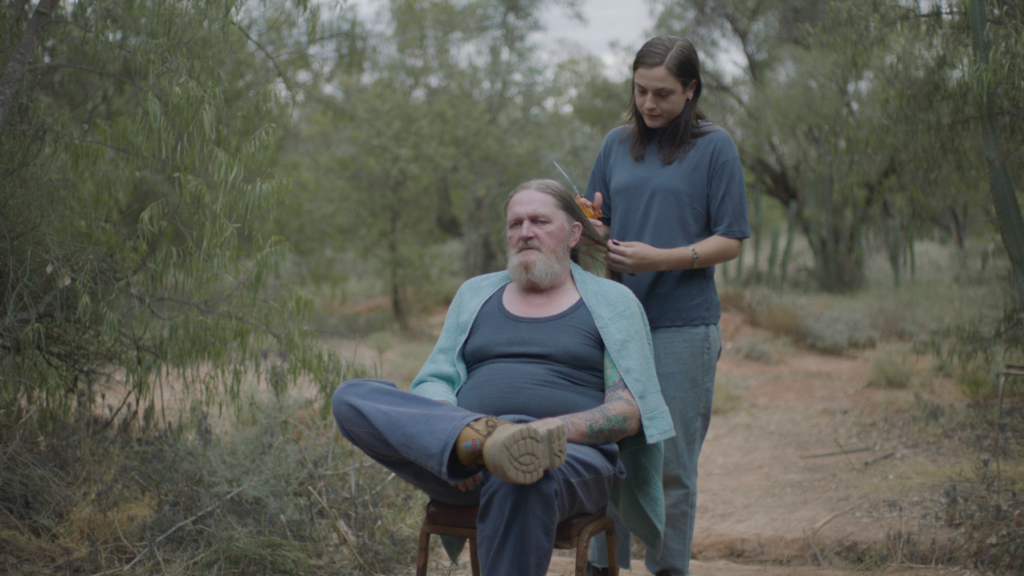
As we learn near the end of the story, some of these men are indeed emotionally damaged by incidents in their pasts – ‘fucked up a bit’, as one local puts it – but they are quite aware of that, and have relocated to Lightning Ridge in order to slowly recover from their psychic wounds. These men (Max in particular) are unafraid to assert their feelings, and even philosophise (in Frank’s case) about the ‘life force’. The landscape around them – above all, the starry night sky – seems to connect them to a sense of the cosmos, of infinity and eternity. This is especially true of Max, superbly incarnated by Jones (previously seen in Amiel Courtin-Wilson’s 2011 film Hail).
Lodkina, as a Russian-born Australian and as a woman, brings a special viewpoint to this rare breed of Aussie male. One can well sense that the time Lodkina spent at Lightning Ridge (while making her 2016 documentary short Lightning Ridge: The Land of Black Opals) has allowed her to discover not only a different kind of landscape and atmosphere, but also a unique type of temperament and personality. Her film goes beyond what Meaghan Morris has identified (in Les Murray’s poetry, for instance) as the ‘masculinist Celtic/Australian tradition’, routinely projected today as a conservative and ‘repressive regime’. Rather, Strange Colours plunges us into (as Morris wisely advises we must venture) the ‘gaps and “incommensurables” in play’ between what we, as consumers of media, theorise in our critical discourse and what we feel or experience in our everyday, human encounters.[5]Meaghan Morris, Ecstasy and Economics: American Essays for John Forbes, Empress Publishing, Sydney, 1992, pp. 109, 111.
Lodkina does not simply celebrate the ‘ordinary Aussie male’ as embodied in the special case of the Lightning Ridge population. There are nuances and complexities in this portrait: even without facing a general air of menace, Melina still experiences her father’s stoicism as somewhat fearsome, and she cannot help but recoil from his intensity. In the larger community, too, there is the unnerving presence of a sole outsider – a thief who has, for his trouble, found himself splattered by the unremovable purple dye planted as a trap by Max. Is this rather unfortunate and pathetic fellow the scapegoat for underlying, unspoken tensions in the town?[6]For an influential theory of this mechanism in cultural narratives, see René Girard, The Scapegoat, trans. Yvonne Freccero, The Johns Hopkins University Press, Baltimore, 1986.
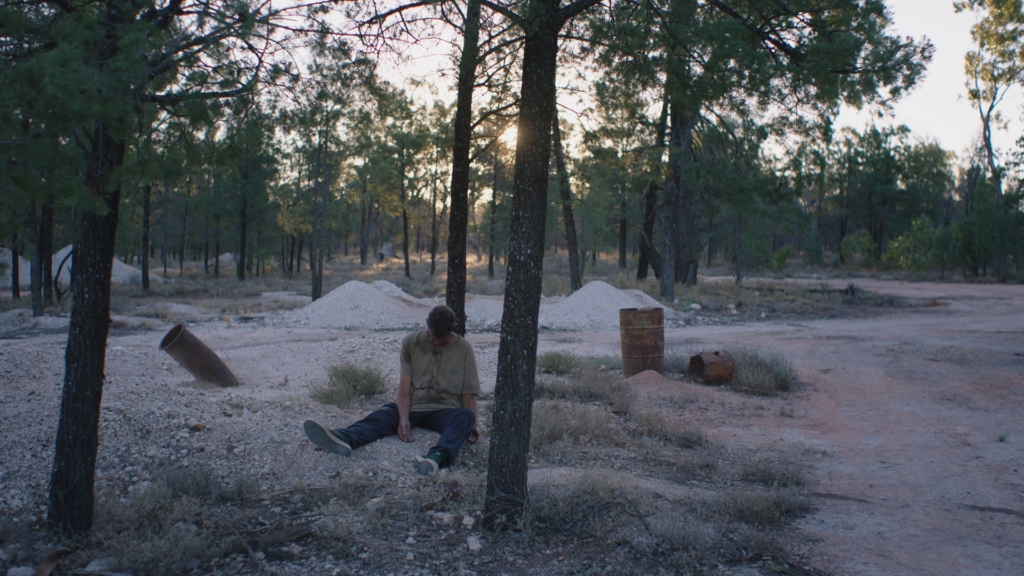
Beyond development hell
There is much to admire in both the art and the craft of Strange Colours. The sparse score by Mikey Young blends with Livia Ruzic, David Ross and Keith Thomas’ careful sound design to provide transitions and enhance atmospheres, rather than to underline emotions or hammer plot points. The ensemble of performances seamlessly blends trained and (one presumes) largely untrained actors. At the film’s centre is Milena, and Cheel’s face is made for cinema. By this, I mean that her expression, whenever viewed at a different angle or lit in a particular way, registers a specific inflection of mood or feeling – even when her performance is subdued, relatively inanimate and far from the typical histrionics of melodrama.
Lodkina has, for several years now, been part of a loose filmmaking group that includes Strange Colours producers Kate Laurie and Isaac Hall (the latter of whom also served as co-writer), along with the prolific Courtin-Wilson. This background experience has undoubtedly given her a valuable understanding of the exigencies of low-budget filmmaking. Strange Colours was made under a strict deadline: it had to be ready within a year for its Venice unveiling. This pressure has, ultimately, served the project well; it certainly saved Lodkina from the fate of so many Australian filmmakers, caught in the ‘development hell’ of constant rewrites for a script that might ultimately never reach the point of production.
Looking at Strange Colours, seasoned observers of the Australian film scene – especially its independent sector – may recall that fleeting moment in the late 1990s when an initiative known as Million $ Movies[7]See ‘Million $ Movies Announced by Australian Film Commission and SBS Independent’, media release, Australian Film Commission, 1 December 1997, <http://afcarchive.screenaustralia.gov.au/newsandevents/mediarelease/1997/release_167.aspx>, accessed 3 May 2018. led to similarly scaled features by Belinda Chayko (City Loop, 2000), Vincent Giarrusso (Mallboy, 2001) and Neil Mansfield (Fresh Air, 1999). But Lodkina hits a higher level of artistic achievement than the creators of those previous efforts; although she has yet to reach the age of thirty, her viewpoint and sensibility as a filmmaker are already well formed, and her ability to marshal the skills of her collaborators towards a common vision is impressive.
Australian cinema has not, in my opinion, shone so brightly since Julia Leigh’s Sleeping Beauty (2011). Let us hope that, unlike Leigh, Lodkina is able to move with relative swiftness on to her next feature.
Endnotes
| 1 | David Bordwell, ‘Venice 2017: College Days’, David Bordwell official website, 7 September 2017, <http://www.davidbordwell.net/blog/2017/09/07/venice-2017-college-days/>, accessed 3 May 2018. |
|---|---|
| 2 | Editor’s note: Stephen A Russell examines Foxtel’s Picnic at Hanging Rock series, as part of a larger essay on television reboots of historic Australian films, in this issue of Metro; see ‘Recurring Nightmares: Dark Australian Classics Reimagined’, pp. 34–41. |
| 3 | See Amber Wilkinson, ‘Mining the Mystery’, Eye for Film, 5 September 2017, <https://www.eyeforfilm.co.uk/feature/2017-09-05-alena-lodkina-on-feature-story-by-amber-wilkinson>, accessed 3 May 2018. |
| 4 | Bordwell, op. cit. |
| 5 | Meaghan Morris, Ecstasy and Economics: American Essays for John Forbes, Empress Publishing, Sydney, 1992, pp. 109, 111. |
| 6 | For an influential theory of this mechanism in cultural narratives, see René Girard, The Scapegoat, trans. Yvonne Freccero, The Johns Hopkins University Press, Baltimore, 1986. |
| 7 | See ‘Million $ Movies Announced by Australian Film Commission and SBS Independent’, media release, Australian Film Commission, 1 December 1997, <http://afcarchive.screenaustralia.gov.au/newsandevents/mediarelease/1997/release_167.aspx>, accessed 3 May 2018. |
